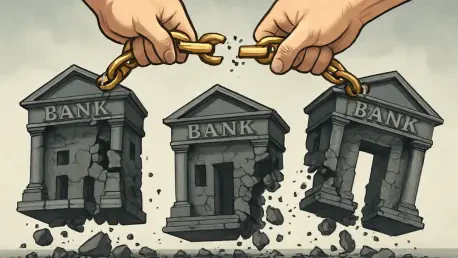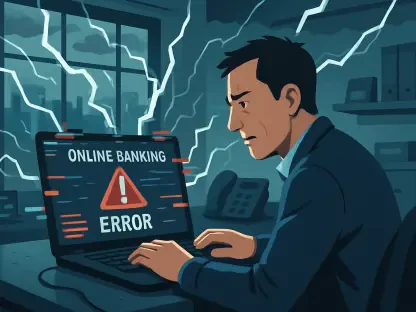What happens when the President of the United States points a finger at some of the nation’s largest banks, accusing them of shutting out entire groups based on political beliefs? In a stunning move, President Donald Trump issued an executive order in August targeting “debanking” practices, putting financial giants like JPMorgan Chase and Bank of America squarely in the crosshairs. This dramatic clash between political power and corporate policy has ignited a firestorm, with implications that ripple far beyond boardrooms and into the lives of everyday Americans seeking fair access to financial services.
The significance of this story lies in its intersection of politics and personal finance. Trump’s order addresses allegations that banks are denying or terminating services to conservative individuals and entities, a practice he has labeled as discriminatory and unacceptable. With responses now emerging in SEC filings from major institutions, this issue strikes at the heart of fairness, freedom, and the role of government in regulating private sector decisions. It’s a battle that could redefine how banks operate and who gets a seat at the financial table.
A Political Tempest Engulfs Financial Titans
The controversy erupted when Trump publicly criticized banking leaders, including JPMorgan CEO Jamie Dimon and Bank of America CEO Brian Moynihan, during a speech at the World Economic Forum in Davos. He urged them to “open their banks to conservatives,” alleging that account closures were driven by political bias rather than legitimate business concerns. This wasn’t just rhetoric; the executive order formalized a push to scrutinize and curb what the administration sees as unfair practices rooted in ideological discrimination.
This public showdown has placed immense pressure on financial institutions to justify their policies. SEC filings from both JPMorgan and Bank of America reveal a cautious acknowledgment of the order, with mentions of ongoing government inquiries and internal reviews. These documents signal that the banks are not ignoring the directive, but they stop short of admitting any wrongdoing, framing their actions as compliant with existing regulations and risk assessments.
The stakes couldn’t be higher as this dispute unfolds. Beyond the immediate accusations, there’s a deeper question of whether banks can remain neutral arbiters in a polarized society or if they’re inevitably drawn into cultural and political conflicts. This tension sets the stage for a broader examination of power dynamics between government mandates and corporate autonomy in the financial sector.
The Rising Tide of Debanking Concerns
Debanking, the practice of banks allegedly refusing or ending services based on political or ideological grounds, has become a lightning rod issue under Trump’s renewed leadership. The administration argues that conservative voices—individuals, businesses, and organizations—are being systematically excluded from essential financial services. This narrative taps into widespread anxieties about equity and access, amplifying public concern over whether banks wield too much unchecked influence.
Data underscores the scale of the problem from the perspective of those raising alarms. A 2025 survey by a prominent conservative think tank reported that over 60% of respondents who identify as politically right-leaning believe they’ve faced discrimination in accessing financial services. While these figures are self-reported and lack independent verification, they fuel the perception of bias, giving weight to the administration’s push for reform and accountability in banking practices.
This issue transcends mere policy debates, touching on fundamental principles of freedom and fairness. As financial institutions become gatekeepers to economic participation, any hint of selective exclusion—whether real or perceived—risks eroding trust. The current spotlight on debanking reflects a critical moment where public sentiment and political will collide with corporate decision-making, demanding clarity on where the line is drawn.
Dissecting Accusations and Corporate Pushback
Trump’s executive order didn’t just call out banks in general; it zeroed in on specific practices and leaders with pointed criticism. The directive labels certain account terminations as “unacceptable,” tying them to what the administration claims are politically motivated decisions influenced by prior regulatory pressures. This accusation gained personal traction when the Trump family initiated legal action against Capital One, alleging the bank shuttered Trump Organization accounts after the January 6, 2021, Capitol events for reasons unrelated to financial risk.
In response, SEC filings from JPMorgan and Bank of America paint a picture of measured compliance rather than capitulation. JPMorgan notes active reviews and legal proceedings related to customer service policies, suggesting a thorough internal reassessment. Bank of America, meanwhile, highlights its engagement with both the administration and Congress to navigate regulations that sometimes result in ending client relationships, emphasizing that such decisions stem from risk management rather than political agendas.
This back-and-forth reveals a deeper rift. While the administration pushes a narrative of systemic bias, banks counter with assertions of objectivity, insisting that closures are driven by regulatory mandates or risk evaluations. The ongoing legal battles, like the one with Capital One, add a layer of complexity, as they test whether courts will validate claims of discrimination or uphold the banks’ defenses of procedural integrity.
Industry Reactions and Regulatory Winds of Change
Voices from within the financial sector and regulatory sphere add critical context to this unfolding drama. OCC Comptroller Jonathan Gould recently stated that examiners are actively monitoring whether banks have abandoned controversial policies, such as those limiting services to industries like firearms. This oversight signals a shift, as regulators appear to align with the administration’s goal of ensuring broader access, even for sectors previously deemed high-risk by some institutions.
Policy reversals by major banks further illustrate the impact of political pressure. Citi, for instance, recently dropped a restriction on firearms sales by retail clients, a policy initially adopted after a tragic school shooting. Such moves are seen by some as a direct response to Trump’s agenda, though banks frame them as part of broader compliance adjustments. Additionally, regulatory bodies like the OCC, FDIC, and Federal Reserve are working to remove reputational risk from bank evaluation criteria, a change supported by lawmakers aiming to eliminate subjective biases in oversight.
These developments suggest a concerted effort to reshape the landscape in which banks operate. The interplay of regulatory adjustments and industry responses highlights a pivotal moment where external forces—both political and supervisory—are redefining the boundaries of financial decision-making. It’s a clear indication that banks are not just passive players but are actively adapting to a new reality of heightened scrutiny.
Charting a Path Through Political and Policy Minefields
For banks and their stakeholders, navigating this charged environment demands strategic foresight. One key approach is transparency, with institutions like JPMorgan and Bank of America urged to clearly articulate in public statements and SEC filings how account decisions are made based on objective criteria, not political leanings. Such openness could help rebuild trust among clients and regulators alike, countering narratives of bias with documented evidence of fair practice.
Engagement with governmental bodies offers another vital tactic. By proactively working with Congress and agencies like the OCC, banks can stay ahead of regulatory changes, such as the phasing out of reputational risk assessments. This dialogue ensures that financial institutions aren’t merely reacting to mandates but are helping to shape policies that balance compliance with operational needs, fostering a more predictable environment for decision-making.
Finally, a client-focused recalibration is essential. Banks must reassess policies on divisive issues—whether related to firearms or diversity initiatives—to ensure decisions are defensible and aligned with both regulatory expectations and customer demands. This balancing act requires meticulous documentation and a commitment to equitable treatment, positioning banks to weather political storms while maintaining their core mission of serving diverse communities.
Reflecting on a Defining Clash
Looking back, the confrontation sparked by Trump’s debanking order stood as a watershed moment for the financial industry. It exposed raw tensions between governmental authority and corporate independence, forcing a reckoning on how banks define fairness in access to services. The responses from JPMorgan and Bank of America, captured in their SEC filings, revealed an industry grappling with external pressures while striving to uphold operational integrity.
The regulatory shifts and policy reversals that emerged during this period underscored a broader transformation in oversight, as bodies like the OCC and FDIC moved toward more objective evaluation standards. These changes hinted at a future where subjective biases might play a lesser role in banking decisions, though the path to that outcome remained fraught with debate and legal challenges.
Moving forward, the lessons from this episode pointed to actionable priorities. Banks needed to double down on transparency, ensuring every decision was backed by clear, risk-based reasoning. Regulators and lawmakers had to continue refining frameworks that prioritized fairness without overreaching into corporate autonomy. For clients, staying informed and vocal about access issues became crucial, as their experiences would shape the next chapter of this evolving story. This saga, though rooted in conflict, offered a chance to build a financial system more attuned to equity and trust.









